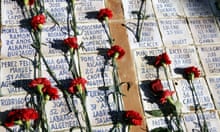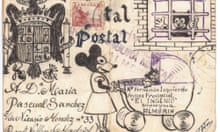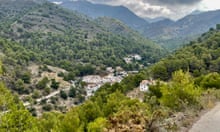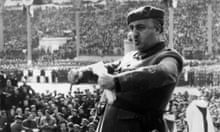A little before lunchtime on Thursday, a helicopter carrying a single body freshly plucked from Spain’s largest mass grave took off from the Valley of the Fallen outside Madrid, climbed above the mountains and disappeared into the bright October sky.
Unlike many of the other 33,832 people buried in the valley’s concrete and granite chambers, this individual did not meet his fate on a battlefield or in an air raid. Nor was he put up against a wall and shot, as so many were during the Spanish civil war.
Francisco Franco died peacefully at the age of 82 in November 1975, heralding the end of the dictatorship that bore his name and that haunts the country to this day. Forty-four years after his body was interred in the hulking mausoleum, it emerged in a coffin carried out of the basilica on the shoulders of eight of his descendants.
The coffin, swathed in a cloth bearing the family crest and topped with a huge laurel wreath tied with red and yellow ribbons, was brought out through the church’s heavy doors just before 1pm.
As the relatives lowered it into the hearse that would take it to the waiting air force helicopter, they let out a stentorian cry: “¡Viva España! ¡Viva Franco!”
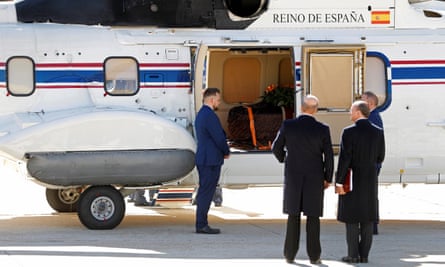
An hour later it arrived at the Mingorrubio-El Pardo municipal cemetery north of the capital, where Franco’s widow, Carmen Polo, is buried in the family mausoleum and where the dictator was reinterred in a private ceremony.
Thursday was a symbolic but undeniable triumph for the socialist government of Pedro Sánchez, whose party has long argued that the site, surmounted by its 150-metre (490ft) cross, had glorified the dictator while ignoring the 500,000 people killed during the war.
The dead of both sides were dug up from mass graves and cemeteries around Spain without their families’ permission and brought to lie in the monument, mute witnesses reburied in their thousands to support the charade that this was a place of national reconciliation.
Only two of the graves were ever marked: those of Franco and of José Antonio Primo de Rivera, the founder of the Falangist party, who was executed by firing squad in November 1936
“Today, Spain is fulfilling its duty to itself,” Sánchez said on Thursday afternoon. “This decision marks an end to the moral insult that the public glorification of a dictator constitutes. We are taking another step towards the reconciliation that can only exist in the democracy and the freedom we all share.”
ProfileWho was Franco?
Show
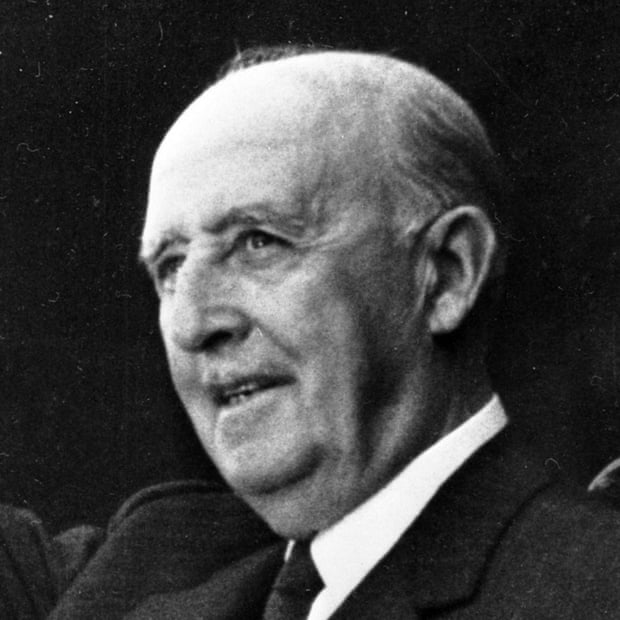
Born in 1892 in Ferrol, Galicia, Francisco Franco Bahamonde was a Spanish general and politician who ruled over Spain as head of state and dictator under the title Caudillo between 1939 and 1975.
He and other officers led a military insurrection against the Spanish democratic government in 1936, a move that started a three-year civil war. A staunch Catholic, he viewed the war and ensuing dictatorship as something of a religious crusade against anarchist, leftist and secular tendencies in Spain. His authoritarian rule, along with a profoundly conservative Catholic church, ensured Spain remained virtually isolated from political, industrial and cultural developments in Europe for nearly four decades.
The country returned to democracy in 1977 but his legacy and place in Spanish political history still sparks rancour and passion.
For many years, thousands of people commemorated the anniversary of his 20 November 1975 death in Madrid's central Plaza de Oriente esplanade and at the Valley of the Fallen mausoleum. And although the dictator's popularity has plummeted, the 2019 exhumation of his body has been criticised by Franco's relatives, Spain's three main rightwing parties and some members of the Catholic church for opening old political wounds.
The path to the exhumation has not been easy. Opposition had come from the dictator’s family, from the National Francisco Franco Foundation, which exists to preserve and promote his legacy, and from the abbot of the valley, a former election candidate for the Falange party.
The Franco family’s position has never altered: he was buried in the valley at the behest of the country’s then prime minister and king, making the exhumation “an act for indefensible political ends”.
The family made their disdain for the entire process patently clear with a well-aimed and profoundly unsubtle parting shot. The man chosen to say mass inside the family mausoleum was an Andalucían parish priest, Ramón Tejero, the son of Antonio Tejero, a Guardia Civil lieutenant colonel who stormed parliament during the failed 1981 military coup.
Tejero Sr made an unexpected appearance at Mingorrubio on Thursday morning, where he was greeted with rapturous chants by the 500 or so people who had turned out to show their devotion to the dictator.
The Sánchez government dismissed suggestions that the timing of the exhumation, less than three weeks before Spain’s fourth general election in as many years, was anything other than fortuitous.
Carmen Calvo, the deputy prime minister, pointed out that the government had tried to exhume Franco over the summer but had been made to wait as his descendants and others appealed to the supreme court. She said Thursday had been the first possible day for the operation.

Nonetheless, the timing has been criticised by both left and right. Pablo Iglesias, the leader of the anti-austerity Unidas-Podemos, accused Sánchez of “bringing the mummy out in a helicopter” for political ends after recent unrest in Catalonia.
Santiago Abascal, the leader of the far-right Vox party, opted for a more direct invocation of the dead of ancient Egypt. “He who moves the dead winds up paying for it with the curse of Tutankhamun,” he warned solemnly, if cryptically.
And yet for all the political pontificating and all the nostalgic fascists with their loyal banners and musty chants, for some the day had little to do with Franco.
Almost four years ago a court granted Maria Purificación Lapeña permission to recover the remains of her grandfather and great-uncle. Manuel Lapeña, a vet, and his brother Antonio, a blacksmith, were executed by Francoist forces in the early days of the war, buried in a mass grave and then dug up decades later and reburied in the basilica without their families’ knowledge or permission.
Like many others, Purificación Lapeña is still dreaming of the day the Franco family dreaded. “We’re not really bothered about what they do with Franco,” she said. “What matters to us is getting the bodies of our relatives back. They need to get all the other bodies out and give them back to the families where possible.”
When that was done, she said, the valley should be deconsecrated, the monks sent packing and the site turned into a historical education centre “where they tell the truth about what happened with the coup and during the Spanish civil war”.
Q&AWho else is buried in Mingorrubio-El Pardo?
Show
Mingorrubio-El Pardo municipal cemetery, which became Franco's new resting place on Thursday, is home to famous and familiar figures besides the dictator's widow, who was buried there in 1988. Franco's right-hand man, Adm Luis Carrero Blanco, was interred there after being killed in 1973 by an Eta bomb so powerful that it blew his car 20 metres into the air. In a black marble mausoleum are the remains of Rafael Leónidas Trujillo, the tyrant who ruled the Dominican Republic for three decades until he was assassinated in 1961. Also buried there are relatives of Saint Josemaría Escrivá de Balaguer, the founder of Opus Dei, and José Banús, the property developer who gave his name to the luxury marina on the Costa del Sol.
Rosa Gil’s grandfather, Pedro, was killed fighting for Franco and now lies in the valley in a box bearing the number 6,427 and the date of his death, 1 June 1937. For the sake of her 83-year-old father, who was one year old when his father died, she wants to bring Pedro out and bury him in the village cemetery in Soria.
“As a Spaniard I’m glad that Franco’s coming out – it’s an important symbolic act for the country,” said Gil. “But my grandfather is a bit more important to me personally. As long as my grandfather stays in there, the joy is tempered.”
About 100,000 victims of the civil war are thought to lie in the unmarked graves where they were buried during the conflict, making Spain the country with the most mass graves after Cambodia.
With the helicopter, the hearse and the cameras gone and its most troublesome ghost evicted at long last, the Valley of the Fallen will soon return to its own extraordinary approximation of normality.
The site and its gift shop will reopen, the school visits will resume and the bones of Manuel and Antonio Lapeña, of Pedro Gil and of tens of thousands of others will continue to lie in their boxes under a huge span of rock, concrete and time, waiting for the day when their families come to bury them for the final time.

